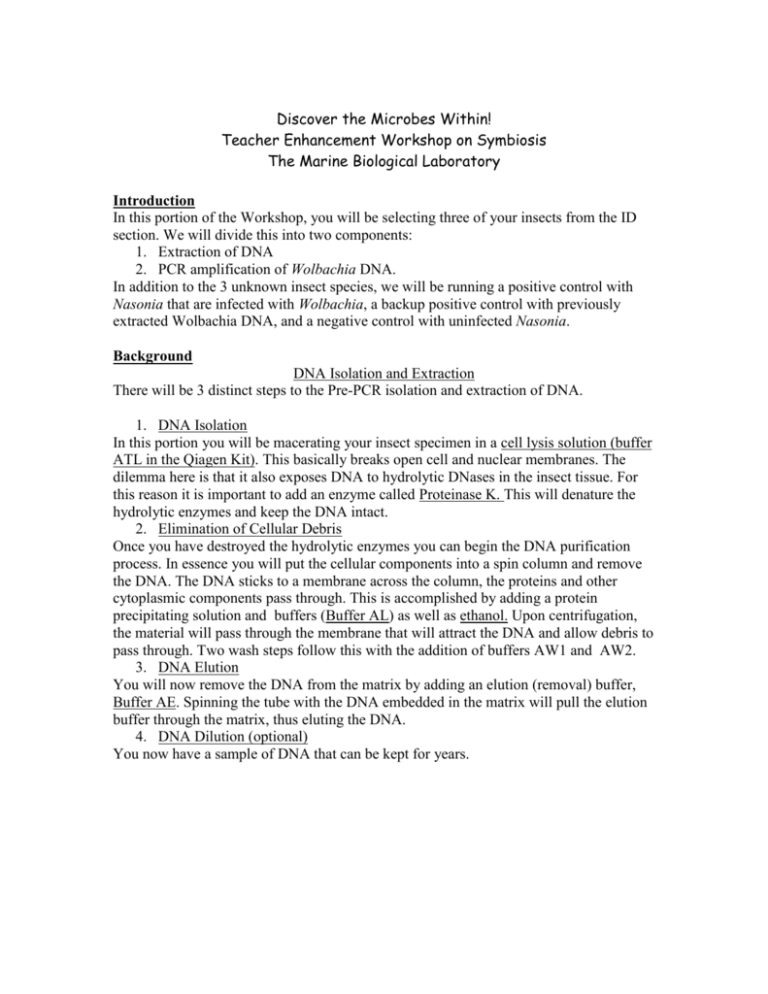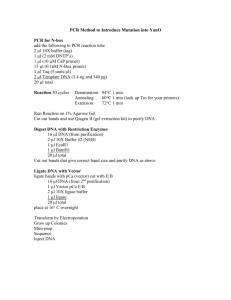Discover the Microbes Within
advertisement

Discover the Microbes Within! Teacher Enhancement Workshop on Symbiosis The Marine Biological Laboratory Introduction In this portion of the Workshop, you will be selecting three of your insects from the ID section. We will divide this into two components: 1. Extraction of DNA 2. PCR amplification of Wolbachia DNA. In addition to the 3 unknown insect species, we will be running a positive control with Nasonia that are infected with Wolbachia, a backup positive control with previously extracted Wolbachia DNA, and a negative control with uninfected Nasonia. Background DNA Isolation and Extraction There will be 3 distinct steps to the Pre-PCR isolation and extraction of DNA. 1. DNA Isolation In this portion you will be macerating your insect specimen in a cell lysis solution (buffer ATL in the Qiagen Kit). This basically breaks open cell and nuclear membranes. The dilemma here is that it also exposes DNA to hydrolytic DNases in the insect tissue. For this reason it is important to add an enzyme called Proteinase K. This will denature the hydrolytic enzymes and keep the DNA intact. 2. Elimination of Cellular Debris Once you have destroyed the hydrolytic enzymes you can begin the DNA purification process. In essence you will put the cellular components into a spin column and remove the DNA. The DNA sticks to a membrane across the column, the proteins and other cytoplasmic components pass through. This is accomplished by adding a protein precipitating solution and buffers (Buffer AL) as well as ethanol. Upon centrifugation, the material will pass through the membrane that will attract the DNA and allow debris to pass through. Two wash steps follow this with the addition of buffers AW1 and AW2. 3. DNA Elution You will now remove the DNA from the matrix by adding an elution (removal) buffer, Buffer AE. Spinning the tube with the DNA embedded in the matrix will pull the elution buffer through the matrix, thus eluting the DNA. 4. DNA Dilution (optional) You now have a sample of DNA that can be kept for years. PCR Preparation and Amplification Once you have your purified DNA, the key is to somehow amplify only the Wolbachia DNA and ignore the DNA of the other countless bacteria, protozoans, and of course insect DNA. To do this we use a primer that is specific to the DNA that codes for 16S ribosomal subunit of Wolbachia. Clearly, this will not amplify eukaryotic DNA (since they do not have 16 S ribosomal subunits) and is specific enough to Wolbachia that it will not amplify other Prokaryotic DNA. 1. Sample Preparation To each of your 5 samples from the DNA preparation you will add several components: a. Each tube has a pelletized mixture called “master mix”. This material contains Taq polymerase, MgCl2, Buffer, and DNtps. b. Primers- both a forward and reverse primer 2. Sample Amplification Assuming that there is Wolbachia DNA, the primers will anneal to the target sequence and amplify the DNA which can be seen in the next portion of the workshop when we run the agarose gels. Part 1 DNA Isolation Preparation 1. In the chart below note the contents of what you will put in each tube. Tube Contents # 1 + control 2 - control 3 4 5 2. Mark 5 tubes 1.5 microliter eppendorf tubes with the numbers 1-5. Also place your initials on each tube so that you can identify them. DNA Isolation*note- it is important to do step 3 as rapidly as possible. Macerated tissue releases DNases which lead to a rapid breakdown of DNA. 1. Place up to 25 mg. of insect tissue into each of your 5-1.5 ml tubes. 2. Place 180 microliters of Buffer ATL into each tube. 3. Macerate thoroughly using a microfuge tube pestle. Be sure to use a different pestle for each tube. Immediately add 20 microliters of Proteinase K, mix by vortexing or inverting 25 times. 4. Now incubate for 45 minutes-3 hours at 55C. If need be, it can be incubated overnight without a problem. 5. Mix by vortexing for 15 seconds or inverting 25 times. 6. Add 200 microliters of Buffer AL to the sample. Mix thoroughly by vortexing or inverting 25 times and incubate at 70C for 10 minutes. 7. Add 200 microliters of ethanol (96-100%) to the sample and mix thoroughly by inverting 25 times or vortexing. Cellular Debris Removal 1. Start by labeling 15-2.0 eppendorf tubes 1-5.(three of each). Be sure to include your initials. These are your collection tubes to use through the washing process. 2. Pipet the mixture from tube 1 of step 7 (including any precipitate) into a DNeasy Mini spin column placed in the 2.0 eppendorf tube labeled “1”... Repeat this process with the four other tubes. Centrifuge for 1 minute. Discard flow-through in the bottom of the collection tubes as well as the collection tube itself. 3. Place the DNeasy Mini spin column from tube 1 into a new 2 ml. collection tube labeled “1”, add 500 microliters of Buffer AW1. Repeat for all 5 tubes and centrifuge for 1 minute. Discard flow-through and collection tubes. 4. Place the DNeasy Mini spin column from tube 1 into a new 2 ml collection tube labeled “1”and pipet 500 microliters of AW2 into the column. Centrifuge for 3 minutes. Gently remove the spin column without letting in come in touch with the material at the bottom of the collection tube. Examine the spin column to make sure it is visibly dry. If it is not dry, let it air dry for 5 minutes. DNA Elution and Dilution 1. Label 5-1.5 ml Eppendorf tubes with 1-5 and your initials. These will contain your purified DNA samples. 2. Place the spin column into a clean 1.5 ml tube and pipet 200 microliters of Buffer AE directly onto the membrane. 3. Incubate at room temperature for 1 minute. 4. Centrifuge for 1 minute to elute. 5. Discard the spin column, and label the 1.5ml tube. Store in 4C fridge until PCR. Part 2-DNA Amplification PCR Detection of Wolbachia The thermal-cycler has been programmed for the optimum settings for this part of the experiment. These settings are: 2 cycles 2 min@95 C 1 min@60 C 1 min@72 C 35 Cycles 30 sec. @95 C 1 min @ 60 C 45 sec @72 C 1 cycle 5 min. @72 C 1. Get 6 PCR tubes. Each of these already contains a bead of “master mix”. Note that we will use 6 tubes because we are providing a previously isolated sample of Wolbachia DNA. 2. In each tube, add the materials in the sequence below (total volume of 25 microliters). Be sure to change pipette tips for each addition: a. 2 microliters of DNA template taken from your prepared sample b. 2 microliters of Primer W-spec forward c. 2 microliters of Primer W-spec reverse d. 19 microliters of sterile distilled water 3. Cap and gently tap the bottom of each tube to mix the components. Once everyone has prepared their samples, the thermal cycler can be turned on. 4. After PCR has run, you can proceed to the gel electrophoresis portion of the lab. Sample Flow Chart DNA Isolation 1 2 3 4 Use 1.5 M. tubes Add ATL Macerate and Add Proteinase K Incubate Vortex Add Buffer AL, Vortex, and Incubate Add Ethanol and Vortex 5 List of Workshop Components and Some Vendors Bio-Rad 1-800-4BIORAD 2000 Alfred Nobel Drive Hercules CA 94547 1)Aquapure DNA Tissue Kit Catalog number - 732-6343 $115.00 each will do 100 preps- this is one kit you can use, another is the Qiagen kit listed below. 2)1.5 ml Micro test tubes Catalog number-223-9501 Quantity- 1 bag of 500 @$24.00 3)Small Pipette Tips-TBR14 (racked) Catalog number-223-9354 10 racks with 96/rack @ $43.00 4)Medium pipette tips TBR 35 (racked) Catalog number-223-9347 5 racks with 200/rack @ $43.00 5)Large pipette tips TBR 40 (racked) Catalog number-223-9350 10 racks with 100/rack @ $47.00 Qiagen Qiagen.com 1)DNeasy Tissue Culture Kit Catalog Number-69504 $118.00- will contain 50 spin columns. More expensive that Aquapure but much simpler. Comes with 2 ml. Eps, buffers and Proteinase. Does not contain RNAse. Buying in bulk is much cheaper…$485.00 for 250. 2)RNase A (Optional step, we will not do it in this lab) Catalog Number-19104 $129.00 for 2.5 ml- This is a relatively large supply and will can be frozen Wards Scientific 1-800-635-8439 1) 95-100% Ethanol Catalog number-950W6208 Quantity- 1 4L bottle @$14.10 2)99% Isopropanol (Specific to Aquapure kit protocol) Catalog number-950W8706 1-500ml bottle of 99% isopropanol at $6.80 3)TE(for DNA dilution) Catalog number-943W8102 1 bottle @ $5.50 Daigger Lab Supplies 1-800-621-7193 620 Lakeview Parkway Vernon Hills, IL 60061 1)Pellet Pestle Rod Catalog Number- PX2486B 100/bag @ $58.23 each bag 2)Sharpie Black Markers Catalog number-PX 5046 A 12 @ 12.80/box Amersham Biosciences Amersham Biosciences.com PuReTaq Ready to Go PCR Beads Catalog number27-9558-01 This includes 0.5 ml PCR tubes which I am assuming fit your thermal cycler These are one-dose PCR beads, each of which comes with Taq, buffers, Mg, dNTP's , stabilizers and BSA. $182.00 each. (96 reactions)








